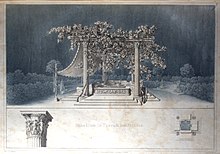Stibadium

A stibadium ( Latin 'semicircular dining sofa ', Greek το στιβαδιον from η στιβας 'paved street'; 'bed, sofa sprinkled with flowers or plants') was a semicircular variant of the installation of sloping benches, the lecti triclinares , in Roman dining rooms where the dinner party lay and the food was served. This type of installation is mentioned in writing as early as the first century AD and was already common for outdoor dining. Inside the aristocratic townhouses and mansions, the arrangement is not traceable before the late 2nd, early 3rd centuries AD. The traditional, right-angled arrangement of the dining sofas in the shape of the triclinium continued, but stibadium predominated in the 4th and 5th centuries AD. A semicircular camp for four to six guests was created, which was also called sigma or accubitum . This arrangement was also set up under a roof in the open air, so that the term stibadium also describes an open arbor resting on pillars and equipped with benches.
Pliny the Younger describes the stibadium in the hippodrome of his villa in Tuscis with these words:
“At the end of the Hippodrome, a white marble stibadium is shaded by a vine, which four Carystian [d. H. of green marble] pillars. From the stibadium, as it were pushed out by the weight of the person lying on it, water flows into small tubes, is caught in a hollowed-out stone, held in a finely worked marble basin and regulated with a hidden device so that it overflows in but never overflows. The plate with the starters and the heavy dishes are placed on the edge, the lighter ones swim around on boats and birds […]. "
Archeological
Semicircular (sigma-shaped) dining sofas for a sigma meal were depicted variously in antiquity, for example in catacomb painting. They can also be found on late Roman dishes such as a large silver plate from the Seuso treasure .
Reception history

In the 19th century, lavishly designed stibadia adorned with figures, mythical and hybrid creatures were part of the equipment of large gardens as outdoor seating for leisure hours.
See also
literature
- Franz Poland : Στιβάδειον (stibadium). In: Paulys Realencyclopadie der classischen Antiquity Science (RE). Volume III A, 2, Stuttgart 1929, Col. 2481.
Web links
- Stibadium from Faragola (English)
- Christopher Daniel: Recipes, dishes and table manners of the ancient Romans including the cultural-historical aspect, presented at Petrons Cena Trimalchionis
- Stibadium of the Villa Liegnitz at the Park of Sanssouci, Potsdam
